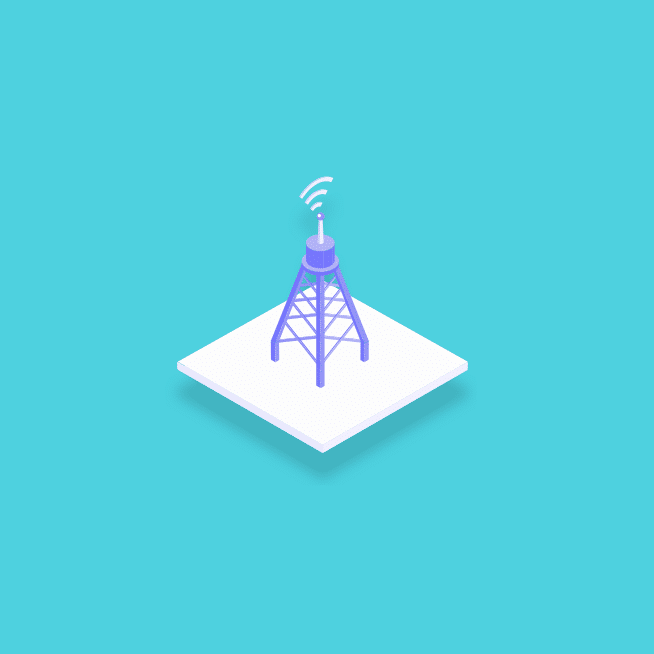
With the development of 5G and the rapidly expanding IoT industry, operators will need more spectrum to keep up with high demand. To solve this problem, the FCC has developed the Citizens Broadband Radio Service (CBRS) to alleviate the shortage of frequencies available for wireless communication services. With consumer mobile data consumption growing at a rate of 57% annually, bandwidth requirements are increasing at a level carriers are struggling to keep up with. Innovating tiered spectrum, CBRS will allow an alternative to carrier services, Wi-Fi, and LPWANs – with several benefits.

The Federal Communications Commission has sought to meet the demand for broader wireless bandwidth through the reassignment of some bands. The CBRS band is the 3.55 – 3.65 GHz reallocated from the military spectrum to permit commercial use.
In order to keep it operable for its original purpose as well as public use, the FCC has assigned bands to give priority access to higher-tier users. In this case, Incumbent Systems – or Incumbents – are the highest tier. This includes the military and government users, who were the preexisting users. The PALs – or Priority Access/Licensed users – is a level any company, person, or entity can achieve through an auction process, with limitations on how many can be obtained. Finally, there is GAA, or General Authorized Access, which is the lowest tier. This can be understood as operating just as the 3.65 band is today, where users do not have ranking over others and must cooperate.
CBRS will make private LTE networks feasible.
Not only will CBRS improve LTE services from service providers, it will also enable enterprises to build their own private LTE networks. Rather than relying on Wi-Fi or a wireless carrier, companies now can create a secure private LTE network to run corporate specific applications. This ultimately would lower operational costs and ease some complexity when building custom applications. Ideally, it will make traffic exclusive and therefore run at a higher speed with a more localized influx.
For example, Nokia, Qualcomm, and Alphabet Access (parent of Google) have created a private LTE network at Las Vegas Motor Speedway with the hopes of giving fans a 360-degree virtual reality view into the cars in real time. CBRS will allow the Speedway to use its own network for the VR view, and other communications by its occupants rather than operate on the public network in Las Vegas – which is surely collecting a larger traffic. The private LTE will run faster, and more focused – rather than get mixed up in the other wireless communication taking place around it. All thanks to CBRS.

The VR experience would look something like this – giving viewers a view into the cars in real time while watching the actual race from their seats.
Providing alternatives for IoT connectivity and LPWANs.
Private LTE networks, made possible by CBRS, can also serve as an IoT connectivity solution. Internet of things devices could connect to private LTE networks in an enterprise – enhancing industrial IoT, commercial IoT, and more. This could reduce downtime and expand the bandwidth of operations, so they don’t have to compete for priority – the possibilities are astonishing. CBRS could compete with wireless carriers and Low-Power Wide Area Network (LPWAN).
CBRS outshines Wi-Fi in this way – by being further reaching. Traditionally, LPWANs and carriers were the only source for network that wasn’t localized like in Wi-Fi. Wi-Fi gained popularity due to its economic and technical accessibility. It offered the first of its kind private networks and is easy deployment. However, Wi-Fi still requires several access points to cover an area well – and has no hand-off capabilities. CBRS LTE networks are expected to reach this same level of accessibility and affordability, but also extend beyond a mile in reach and require fewer small cell base points. CBRS backers say the economics of this technology are much better than those of distributed antenna systems and they contend the speed and consistency of service will be much better than Wi-Fi. Needless to say, the future is bright for CBRS.
CBRS is changing the way network is owned and operated.
To curb the competition, major carriers are buying into CBRS in the hopes of maintaining their subscription base. Carriers, cable companies, and enterprises are looking to get into wireless through cellular-based service extensions, according to Network World. The 3.5 GHz band would extend coverage and capacity of pre-existing LTE services, working indoors and outdoors. Also, it would lower the costs of entry for non-traditional wireless carriers, and potentially increase coverage in rural areas.
Where wireless carriers are concerned, CBRS means unbridled expansion. Historically, they were having to share the band with Wi-Fi. Now, they have the option to reduce complexity by using LTE that will provide a network that should be better than Wi-Fi. Large carriers are looking to use the band to densify LTE networks through small cell in urban areas.
As for cable operators, CBRS could mean more spectrum holdings. They could deploy LTE networks and become Mobile Virtual Network Operators, or MVNOs.

This could also mean big changes for the marketplace in 5G. Industry experts speculate that the sharing system will pave the way for 5G throughout the US and bring harmony in coordination globally. If successful, the CBRS model of effective and fair spectrum could be repeated by regulators in their own markets – whether LTE or 5G or whatever comes next!
CBRS is the ultimate test to the shared spectrum theorem. If it proves to be more efficient and accessible as promised, it could mean huge changes to the way the market approaches 5G, LTE, and whatever may come next.


